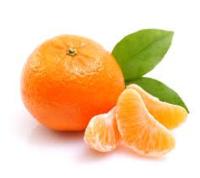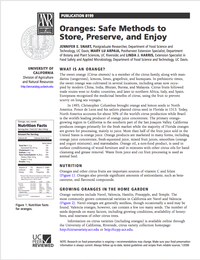Oranges
PRESERVING THE SEASON’S BOUNTY
Citrus season is in full swing! Here in Southern California we are treated to a great variety of citrus – from Grapefruit to Tangerines and everything in between. One of the most popular citrus fruits is the orange. Whether it be a ‘Cara Cara’ or a ‘Washington Navel’, there is a way to preserve your bountiful crop.
This is a synopsis of UCANR Publication 8199, entitled "Oranges: Safe Methods to Store, Preserve, and Enjoy", dated January 2006. The entire UCANR publication is available for free online, here. Please refer to it for additional information.NOTE: Research on food preservation is ongoing - recommendations may change. Make sure your preservation information is always current. Always follow up-to-date, tested guidelines and recipes from reliable sources.

Nutrition – Oranges and other citrus fruits are important sources of Vitamin C and folate. Oranges also provide significant amounts of antioxidants such as beta-carotene and flavonoid compounds.
Selecting Oranges at the Grocery Store – Choose oranges that are firm and heavy for their size, with fine textured skin and no soft spots. Oranges should be free of cuts and bruises.
Selecting Oranges from Your Home Garden – Oranges do not ripen after they are harvested so it is important to pick the fruit at the right stage of maturity. The orange should have a yellow-orange color on at least 25 percent of the peel. Sample the fruit periodically to check for maturity. Harvest oranges from the tree by gently snapping or slipping the fruit from the stem. When fruit is snapped off the tree, the peel may tear at the stem. These fruit should be used first because, with a break in the peel, they are more likely to spoil.
Storing Fresh Oranges – Commercially grown oranges can be stored 3 – 8 weeks when refrigerated. Home grown oranges should be ‘stored’ on the tree until used, or in the crisper drawer of your refrigerator.
Washing Oranges – Oranges should be washed before peeling or cutting. Rub the surface, rinse with running water and dry with a paper towel.
PRESERVATION METHODS: ORANGES
FREEZING ORANGES – Wash the fruit, peel it and divide it into sections. Remove the membranes and seeds before freezing. Read more…
DRYING ORANGE PEEL – Drying oranges is not a recommended method since they are so juicy. However orange and other citrus peels do dry well. Home dried orange peel can be used as a flavoring in favorite recipes, such as breads and other baked items, fudge and other candies, gelatin, tossed and fruit salads, Asian dishes, stuffing, milkshakes, homemade ice cream, cooked cereals and granola.
Dehydration Methods:
Oven Drying
Sun drying
Dehydrator Drying
Microwave Drying – NOT recommended.
Conditioning dried orange peel – Home dried orange peel should have about a 20% water content. After drying the peel, the moisture content of your peels may not be distributed evenly. Conditioning is the process that makes sure that all pieces are equally moist.
Packaging and Storage – Dehydrated orange peel requires very little storage space. Sealed plastic bags or airtight jars will suffice.
CANNING ORANGES
Since oranges have a pH of 3.6 to 4.3, they are considered acidic and can be water bath canned. Use the right equipment properly.
JAMS AND JELLIES
Oranges and other citrus make marvelous marmalades.
See a Citrus Marmalade recipe and read more about any of the topics in UCANR 8199 publication.
Our Food Resources Page has other sources of information and tested recipes.

